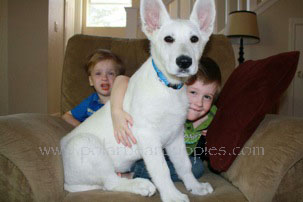Should I choose a Male or a Female? What about Cats and other Dogs?
You’ll find these answers and more as you scroll down this page….
Male or a Female?
Our males and females are equally loving, intelligent, and amazing family members that take little correction and quickly learn what you expect of them. Below are a few differences to consider:
Size: Our female adults (2 yrs. +) usually weigh between 70-85 #. Males weigh between 80-120# Males have about an inch height advantage over females.
Training: For those inexperienced to the shepherd breed, our females are said to be slightly easier to handle because for the most part they are not quite so large. If, on the other hand you have experience with shepherds and like a larger dog, you may want to consider a male.
Urination: Females tend to hold their urine longer than males—some can wait as long as 12 hours if necessary—which might be an advantage in a household where no one is home during the day. Both males and females are almost immediately housebroken by nine (9) weeks of age. On walks, a female will usually empty her bladder all at once while a male may urinate in little spurts along the way.
Polarbear's Max
Children and the elderly: All of our Polarbears make loving companions for a child or an elderly person, however if given a choice and especially if we are talking about children under eight (8) years of age, we recommend a female. Female Polarbear’s are naturally nurturing and protective of children due to their "mothering" abilities. Note that all of our dogs, male and female, are completely trustworthy, understanding that quick movements or an occassional tail pulling is not a threat. For those of you who have children older than eight (8) years of age, males make wonderful playmates. It's our experience that boys love our males, in particular those who may have fewer verbal skills. Boys just seem to connect with our dogs and become best friends.
Prey Drive: All dogs, whether male or female, are born with a prey drive which is essential for their survival. When dogs exhibit dominance, particularly towards humans, they are demonstrating "high prey drive". The majority of shepherd breeders, in our opinion, have no clue that they are breeding dogs with high prey drive. High prey drive dogs are ideal for law enforcement, protection, and as working dogs, not so much for the average family with children! Our dogs have a low prey drive and you can count of them to be extremely stable.
House Dogs: Both males and female Polarbears are extremely well-mannered. Think for a moment of your favorite visitor to your home or house guest, our Polarbears are very respectful and well-mannered indoors. It is yet another reason people love our dogs! As house dogs, some people believe it is a little easier to live with a female due to their smaller size.
Protection: If personal protection is a priority, as a general rule males are larger and stronger and make better guard dogs for personal and home protection. As they age, our males become very focused on protecting their territory, including their family members, so if you desire the best in protection and patrol, then yes, a male is better. Females also make excellent guard dogs and if necessary will put their lives on the line to protect their owners. The difference, again, is size. Many of our females are equally impressive in size and their barks just as intimidating! Any of our clients can tell you that any intruder that comes onto their property that a Polarbear suspects is up to no good will have little chance of succeeding and will be sorry for doing so! The difference between a Polarbear and other dogs, in these circumstances, is that our dogs know the difference between a real threat and a perceived threat. Again, genetics.
If you follow our guidelines, particularly socializing your puppy in a prescribed puppy class, you can't go wrong. The protection our Polarbears provide is priceless.
Cat Families:
For people who like cats, no worries because both our males and females love cats! Or coarse, this all depends upon the cat too, but we have never heard of a Polarbear yet that has not won them over! (See the cat video below)
Multiple Dog Families
Both sexes socialize well with other dogs as long as they are given an introduction period in a neutral area in advance. Our Polarbear brand of GSD is lower on "prey drive" which is one or the traits that determines whether or not a dog will dominate another dog. We have never had to keep any of our dogs apart and they all live together in harmony. One thing that most dog trainers and other experienced handlers agree is that if you already have one dog, your next one should ideally be of the opposite sex. While it may be possible to bring two male dogs together it is much more difficult to have two females sharing the same space. Females sometimes don't get along (think teenage daughters!) The female-female hostility has its roots in the reproductive instincts, and even if spayed, a female will still have the tendency to fight for alpha status with another female.


